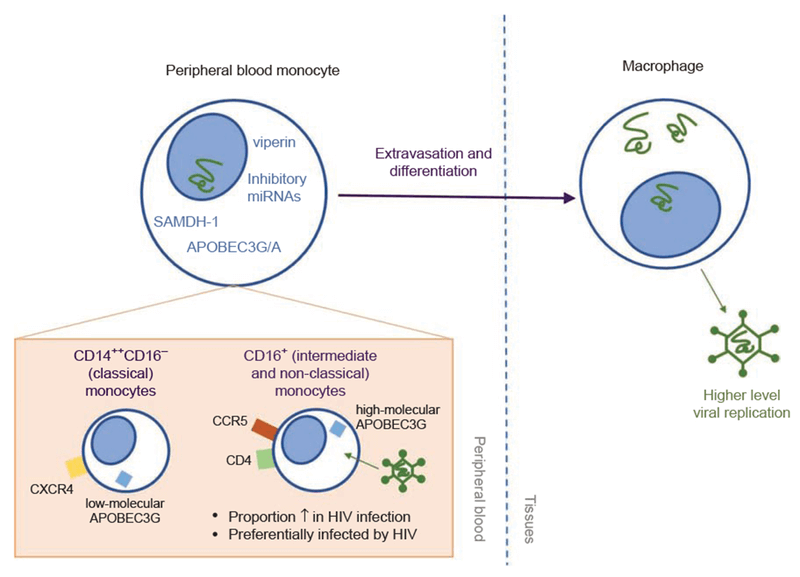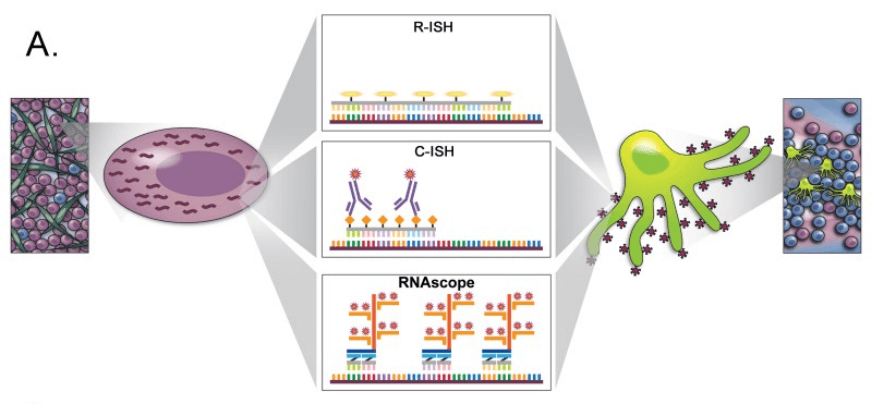Typical Retroviruses (HIV/SIV)
Lentiviral infection is characterized by a very complex interaction with the host and a chronic disease course. Common features of diseases caused by lentiviruses include a long and variable incubation period, sustained viral replication, neurological manifestations, and destruction of specific blood or immune cells. In particular, features associated with non-primate lentiviruses exhibit shared morphogenesis and macrophage tropism, extensive genetic and antigenic variability, and the presence of additional regulatory genes not found in other retroviral groups. For example, studies of human immunodeficiency virus type 1 (HIV-1) and non-human primate simian immunodeficiency virus (SIV) are invaluable for better understanding the pathogenesis of HIV infection. Progress has been made in antiretroviral therapy (ART), but further research is needed to fully decipher the reasons for the persistence of HIV hosts and to find durable cures. In situ hybridization techniques can help to study the mechanism of viral infection in cellular and tissue environments, determine the biological nature of viral latency, and efficiently infect cells in different tissues. Our FISH technology service platform provides in situ visualization solutions for HIV and SIV-related research.
 Fig 1. Monocytes and macrophages are important targets of HIV. (Campbell J H, et al. 2014)
Fig 1. Monocytes and macrophages are important targets of HIV. (Campbell J H, et al. 2014)
HIV/SIV Research by Next-generation in situ Hybridizations
Our FISH technology platform provides in situ analysis testing services for HIV/SIV virus based on next-generation in situ hybridization technology. This service is based on commercial probes and/or custom probes. At present, probes for different loci and subtypes of HIV/SIV virus have been designed, such as probe products targeting different subtypes of HIV1 (subtype A and subtype B) and different strains of SIV. We accept outsourced laboratory services where customers specify probe products for analytical testing. At the same time, our platform also has the ability to design probes according to the targets of interest to customers. If you are interested, please consult our experts.
 Fig 2. Schematic to demonstrate key differences between standard radiolabeled ISH (R-ISH), chromogenic ISH (C-ISH) and the next-generation RNA-scope approaches. (Deleage C, et al. 2018)
Fig 2. Schematic to demonstrate key differences between standard radiolabeled ISH (R-ISH), chromogenic ISH (C-ISH) and the next-generation RNA-scope approaches. (Deleage C, et al. 2018)
Some commercialized HIV and SIV specific probes:
- HIV: Probe series targeting Env, Gag, Pol genes; Probe series excluding Gag and Pol genes; HIV1 Subtype A/B/C/D/AE probe series;
- SIV: SIV strains commonly found in African green monkeys (SIVamg), rhesus monkeys (SIVmac239), and sooty mangabey;
Technology Features
Next-generation in situ hybridization technology enables differential detection of viral RNA and proviral DNA. The highly specific probe design targets sense or antisense sequences to detect the sequences of viruses in different states in the sample. These sequences may include viral RNA in virus particles, proviral DNA integrated with the nucleus of infected cells, viral genomic RNA or mRNA in infected cells, etc.
Creative Bioarray provides analytical testing services based on next-generation in situ hybridization technology to help customers conduct research on typical lentivirus HIV/SIV. Our FISH technical services help clients outsource analytical testing and provide custom probe design services. You will find solutions to your research needs through our technology platform. If you are interested in our service, please contact us for cooperation. We look forward to cooperating with you in the near future.
References
- Campbell J H, Hearps A C, Martin G E, et al. The importance of monocytes and macrophages in HIV pathogenesis, treatment, and cure[J]. AIDS (London, England), 2014, 28(15): 2175.
- Deleage C, Chan C N, Busman-Sahay K, et al. Next-generation in situ hybridization approaches to define and quantify HIV and SIV reservoirs in tissue microenvironments[J]. Retrovirology, 2018, 15(1): 1-10.
All products and services on this website are only suitable for non-medical purposes.


 Fig 1. Monocytes and macrophages are important targets of HIV. (Campbell J H, et al. 2014)
Fig 1. Monocytes and macrophages are important targets of HIV. (Campbell J H, et al. 2014) Fig 2. Schematic to demonstrate key differences between standard radiolabeled ISH (R-ISH), chromogenic ISH (C-ISH) and the next-generation RNA-scope approaches. (Deleage C, et al. 2018)
Fig 2. Schematic to demonstrate key differences between standard radiolabeled ISH (R-ISH), chromogenic ISH (C-ISH) and the next-generation RNA-scope approaches. (Deleage C, et al. 2018)


